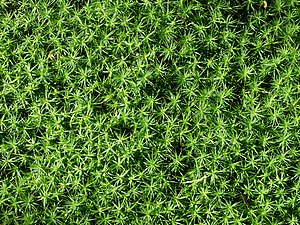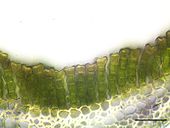Golden maidenhair moss
| Golden maidenhair moss | ||||||||||||
|---|---|---|---|---|---|---|---|---|---|---|---|---|

Polytrichum commune |
||||||||||||
| Systematics | ||||||||||||
|
||||||||||||
| Scientific name | ||||||||||||
| Polytrichum commune | ||||||||||||
| Hedw. |
The golden woman's hair moss ( Polytrichum commune ), also called common or common red- toned moss or large hair-cap moss , is a moss from the genus of red-toned moss ( Polytrichum ). It was voted Moss of the Year 2010 by the Bryological-Lichenological Working Group for Central Europe .
features
The golden maidenhair moss is an acrokarpes (summit fruit) moss that forms relatively conspicuous dark green to blue-green cushions. The cushions are usually a little less rigid than those of the beautiful Widertonmoos . At 10 to 40 cm, the moss has quite long, mostly unbranched stems. This makes it the tallest European moss.
The leaves are arranged in a spiral around the stem. They are narrowly lanceolate, 8 to 12 mm long, protruding when moist and lying dry. The leaves have a distinct rib with many lamellae that extends to the tip of the leaf. In contrast to the similar beautiful Widertonmoos, the lamellae have a furrow on their upper edge. The leaf margin is serrated up to the sheath.
Particularly noticeable is the square, yellow to red-brown spore capsule, which when young is surrounded by a hood made of relatively light, long felt hairs (name!). The spore capsule is located on a 6 to 12 cm long stem that stands at the end of a stem.
use
Due to its good tensile strength and toughness, so-called moss braids were woven from the moss in the Middle Ages, which were used, among other things, as ship ropes.
Occurrence
It is an almost cosmopolitan species. The main occurrence of the golden maidenhair moss extends up to altitudes of about 2000 meters. It colonizes rather acidic, moist locations and is more often found in wet places in coniferous forests or in wooded moors.
Analogy magic

The Golden maidenhair moss was in little Destillierbuch of Hieronymus Brunschwig called "Güldin wyder don" or "Güldin wyder death". "Dismiss", "Against", "Lay down" and "Eliminate" were terms of the analogy magic of folk medicine . Selected plants were used for these practices. In addition to the golden lady's hair moss, these were: the brown-stemmed striped fern , the wall rue and - according to Hieronymus Bock (1539, I / 181) - also native sundew species .
"The women are talking about the creeping / Maurrautt should lay down and help out / against it should bring the brown Hörlin with the Lynsen bletlin and help out / the Jungfraw hor [golden lady's hair moss and sundew species ] like that too ."
The alchemists used to represent the materia prima u. a. the golden maidenhair moss, sundew species and celandine . The selection criterion was the golden-yellow color of these plant species.
literature
- Jan-Peter Frahm , Wolfgang Frey : Moosflora (= UTB . 1250). 4th, revised and expanded edition. Ulmer, Stuttgart 2004, ISBN 3-8252-1250-5 .
Individual evidence
- ↑ Heinrich Beck , Dieter Geuenich , Heiko Steuer (Ed.): Reallexikon der Germanischen Altertumskunde . Volume 33: Scales and Weights - Wielandlied. 2nd, completely revised and greatly expanded edition. de Gruyter, Berlin et al. 2006, ISBN 3-11-018388-9 , p. 116.
- ↑ Hieronymus Brunschwig . Small distilling book . Strasbourg 1500, sheet 120r digitized
- ↑ See also in the concise dictionary of German superstitions , vol. I / 21: Abdontag ; Vol. I / 123: Dismissing ; Vol. IX / 559: Widerton .
- ↑ Hieronymus Bock . New Kreütter book. Strasbourg 1539, book I, cap. 181 digitized
- ↑ Hieronymus Bock . New Kreütter book. Strasbourg 1539, book I, cap. 182 digitized
- ↑ Otto Brunfels . Contrafeyt Kreueterbuch. Strasbourg 1532. Digitized



